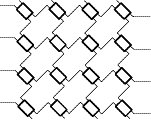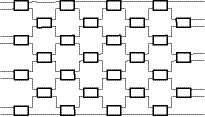Section 14.3. Large-Scale Optical Switches
14.3. Large-Scale Optical SwitchesLarge-scale optical switches can be achieved either by implementing large-scale star couplers or by cascading 2 x 2 or even 1 x 2 multiplexers. However, the implementation of star couplers larger than 2 x 2 is expensive, owing to difficulties in the manufacturing process. Cascading small switches is a practical method to expand a switch. This method of switch expansion can make a desired- size switch quickly and at lower expense. However, some factors affect the overall performance and cost of an integrated switch, as follows :
There are several proposed topologies for large-scale switching networks. Two of the more practical ones are crossbar and the Spanke-Bene 14.3.1. Crossbar Switching Network The architecture of an optical crossbar is not quite the same as the one in Chapter 13, as indicated in Figure 14.4. An optical crossbar is wide-sense nonblocking. The fundamental difference in the architecture of the optical crossbar and traditional crossbars is the existence of different and variable-length paths from any input to any output. This feature was created in the structure of the optical crossbar to minimize the crossover of interconnections. An optical crossbar is made up by 2 x 2 switches. Denoting the number of switches a signal faces to reach an output port from an input port by Equation 14.1 Figure 14.4. A 4 x 4 wide-sense nonblocking optical crossbar without waveguide crossovers, using basic 2 x 2 switch elements where n is the number of inputs or outputs of the crossbar. In an n x n crossbar, the number of required 2 x 2 switches is n 2 . The 16 2 x 2 switches in the Figure 14.4 crossbar are structured in an appropriate way. The main issue with the crossbar structure is its cost, which is a function of n 2 . But a great advantage of such an architecture is that the switch can be manufactured without any crossovers. 14.3.2. Spanke-Bene |
EAN: 2147483647
Pages: 211
 network
network  , the bounds for
, the bounds for 
